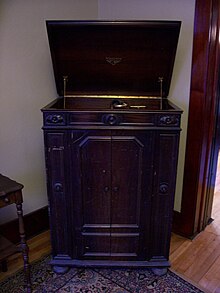|
Victor Orthophonic Victrola The Victor Orthophonic Victrola, first demonstrated publicly in 1925, was the first consumer phonograph designed specifically to play electrically recorded phonograph records. The combination was recognized as a major step forward in sound reproduction. Electrical recording was developed by Western Electric, although a primitive electrical process was developed by Orlando R. Marsh, owner and founder of Autograph Records. Western Electric demonstrated their process to the two leading recording companies, Victor and Columbia, who were initially unwilling to adopt it because they thought it would make their entire existing record catalogs obsolete. However, parched revenues in the record industry caused by the mushrooming new medium of radio soon forced both Victor and Columbia to begin experimental electrical recording.[1] The design of the Orthophonic was informed by progress in telephony and transmission-line theory. It was developed by two Western Electric researchers, Joseph Maxfield and H. Harrison. Early electrical recordings sounded harsh when played on the acoustic phonographs of the day, which had been designed by trial and error, had highly "colored" frequency response, and emphasized higher frequencies. The researchers invented the exponential horn, and, on realizing that it needed to be nine feet long to reproduce the lowest frequencies on the new discs, designed a method for "folding" the horn into a cabinet of practical size. The design was released by Victor as the "Orthophonic" Victrola in the autumn of 1925. Its first public demonstration was front-page news in The New York Times, which reported that:
A Wanamaker's ad from October 31, 1925 invited people to come to "Wanamaker's Salon of Music" and "join the throngs" who were "HEARING the new Victor Orthophonic Victrola . . . . imagining performers present . . . . blinking unbelieving eyes" and promising "you will never forget it if you live to be one hundred!"[3] A historian comments that,
As part of a publicity blitz, Victor designated November 2, 1925 as "Victor Day" and, within days, was "swamped with orders exceeding $20 million."[4] List prices ranged from $95 (≈$1,400 in 2020 dollars) to $300 depending on cabinetry. $375 "Victrolas with Radiola" incorporated a "five-tube Radiola tuned radio frequency receiver with orthophonic reproduction." A $650 "Victrola-Electrola" incorporated a "two-way valve" allowing both "Orthophonic as well as electrical reproduction," while the $1,000 (≈$14,820 in 2020 dollars) "Orthophonic Victrola—Radiola and Electrola" had it all, including an eight-tube Radiola Super-Heterodyne [sic].[5] Dance music enthusiasts were not initially impressed; it was classical music that "sold" the new device. The Orthophonic became recognized as a status symbol. Liberace's father, for example, though unemployed, maintained his self-image as an artiste by "own[ing] the best record player available, a 'very special Orthophonic Victrola'"[6] In the early 1950s, the memory of the Orthophonic was fresh enough for RCA Victor to introduce the name "New Orthophonic" for its improved recording process and line of high-fidelity long-playing records and "Stereo-Orthophonic" was applied to RCA Victor's celebrated "Living Stereo" recordings issued later in the decade. NoteThe term "orthophonic" had previously been used in connection with speech therapy; an 1870 book mentions a therapist who "devised a series of orthophonic exercises to restore the harmony between nervous action and the organs of articulation."[7] See also
References
|